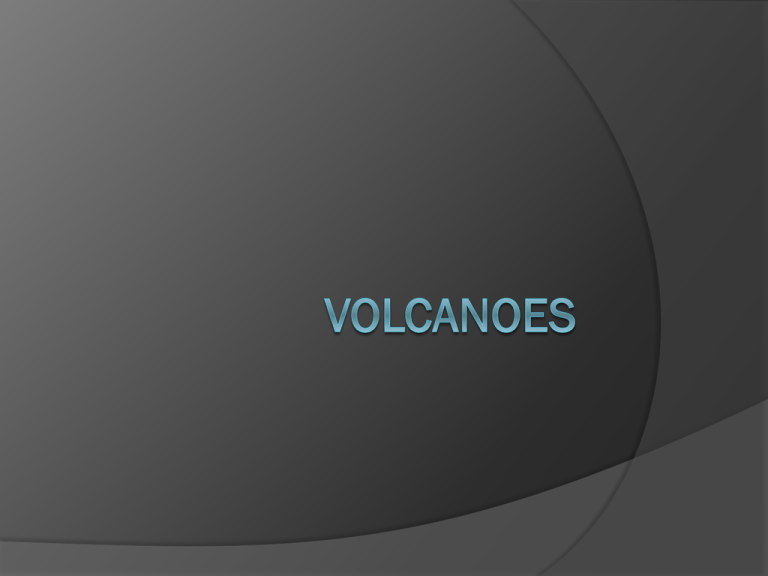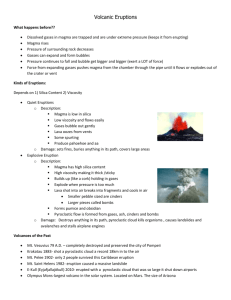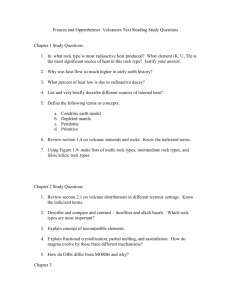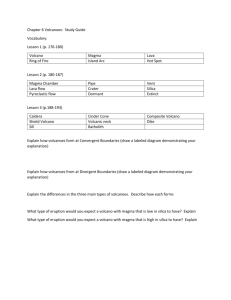Volcanoes
advertisement

MAGMA All volcanoes are fueled by magma deep beneath Earth’s surface Magma is a mixture of molten rock, suspended mineral grains, and dissolved gases Depending on the composition rocks begin to melt at temperatures between 800°C and 1200°C Factors affecting magma formation Temperature If rocks melt at temperatures found in the asthenosphere, and temperature increases with depth, then why isn’t the entire mantle liquid? What other factors affect the formation? Pressure Pressure increases with depth because of overlying rocks. As pressure increases, the temperature at which a substance melts also increases Most rocks in Earth’s lower crust and upper mantle do not melt to form magma even though the temperatures may be hot enough Greater Pressure = Greater Melting Temperature Water Content Water can be found in the pore spaces of some rocks and can be bound into the crystal structure of some minerals A wet mineral or rock will melt at a lower temperature than the same mineral or rock under dry conditions Greater water content = lower melting temperature Magma Composition Many different factors determine the composition of magma Viscosity ○ The internal resistance to flow Gas Content Silica Content Source Material Magma Types 3 Different types of magma Basaltic ○ Forms when rocks in the upper mantle melt ○ Low viscosity ○ Contain small amounts of dissolved gases and silica Eruptions are relatively quiet Andesitic Found along subduction zones Relatively high silica content Has an intermediate viscosity ○ Volcanoes said to have intermediate eruptions Rhyolitic Forms when molten material rises and mixes with the overlying silica and water rich continental crust Highest viscosity ○ Resistant to flow Large volume of trapped gas ○ Very explosive eruptions Viscosity Viscosity of magma depends upon temperature and composition Hotter the magma or lava, the lower the viscosity Amount of silica in magma or lava also increases viscosity ○ High in silica = high in viscosity Intrusive Activity Magma is less dense than surrounding rocks. Moves upward and comes into contact with or intrudes the overlying crust What happens deep in the magma chamber as the magma slowly cools? ○ As they cool they begin to form intrusive igneous rock bodies ranging in size ○ These intrusive igneous rock bodies are called plutons Batholiths & Stocks Batholiths = largest plutons Cover at least 100 km2 Common in the interiors of major mountain chains Composed primarily of granite Stocks are irregular shaped and smaller in size than batholiths Laccoliths A mushroom-shaped pluton with a round top and flat bottom Relatively small in comparison to batholiths and stocks Sills Sill = a pluton that forms when magma intrudes parallel to layers of rock Range from only a few centimeters to hundreds of meters in thickness Dikes Dike = a pluton that cuts across preexisting rocks Form when magma invades cracks in surrounding rock bodies Anatomy of a Volcano Volcanism produces various features that alter Earth’s landscape Vent Opening in the crust through which lava erupts Over time lava flowing from the vent can accumulate forming a mountain known as a volcano Crater A bowl shaped depression, around the vent, at the top of a volcano Connected to the magma chamber by the vent Calderas Craters are usually less than 1km in diameter Larger depressions = caldera Up to 50 km in diameter Can form when volcano summit or side collapses into an empty magma chamber Types of Volcanoes Shield Broad, gently sloping sides Nearly circular base Formed when layers of lava accumulate Non-explosive eruptions Hawaiian Islands Ex. Mauna Loa, Kilauea Cinder-Cone Formed when material ejected into the air falls back to Earth and piles up around the vent Steep sides Small Magma contains more water and silica = more viscous Explosive eruptions Composite Layers of volcanic fragments alternate with lava Magma contains large amounts of silica, water, & gas Much larger than cinder-cones Violently explosive Ex. Mount St. Helens Volcanic Material Tephra = rock fragments thrown into the air during an eruption Classified by size ○ Dust, ash, lapilli, volcanic blocks ○ Volcanic bombs Pyroclastic Flow Clouds of gas, ash, and other tephra Move at incredible speeds 200km/h Temperature can exceed 700°C 1902 Mount Pelée Where Do Volcanoes Occur? 80% occur along convergent boundaries Subduction zones Pacific Ring of Fire 15% occur along divergent boundaries Rift zones along ocean ridges 5% occur away from boundaries Hot Spots Hot Spots = unusually hot regions of Earth’s mantle Plumes of material rise toward the surface Magma melts through the crust to form volcanoes Creates chains of volcanoes Provide important information about plate motions ○ Rate and direction








